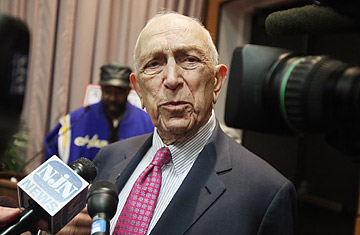
U.S. Senator and World War II veteran Frank Lautenberg
Correction Appended: April 16, 2010
When Congress passed the Toxic Substances Control Act (TSCA) — the law designed to regulate potentially dangerous chemicals in the environment — in 1976, Gerald Ford was still President and Queen's "Bohemian Rhapsody" was the No. 1 song of the year.
Thirty-four years have passed since the TSCA's adoption, and in that time nearly every major environmental law of the 1970s — like the Clean Air Act and the Clean Water Act — has been revised to reflect changing science and greater public concern about the environment and human health. But the TSCA has remained stuck in the 1970s, an aging throwback that never gave Washington any real power to protect people from potentially toxic chemicals.
It may finally be time to bring chemical regulation out of the polyester era. On April 15, New Jersey Senator Frank Lautenberg introduced new legislation that would overhaul the regulatory system, requiring manufacturers to prove the safety of chemicals before they could be sold. That represents a much needed change from the current system, in which the burden of proof falls on the Environmental Protection Agency (EPA) to show that a chemical is dangerous to human health or the environment before the agency can regulate it. "America's system for regulating industrial chemicals is broken," said Lautenberg in a statement. "My Safe Chemicals Act will breathe new life into a long dead statute by empowering the EPA to get tough on toxic chemicals."
Environmental and health groups hailed Lautenberg's legislation, the product of more than a year of consultation with green groups, regulators and the chemical industry. "The Safe Chemicals Act would go a long way to bringing chemical safety into the 21st century," says Andy Igrejas, the national campaign director for Safer Chemicals, Healthy Families, a coalition of pressure groups concerned with chemical safety. "We are very excited about the debate that's going to begin today."
Lautenberg has been trying for the past couple of years to push reform of the TSCA, but this time it might actually take. Even the chemical industry, which has long resisted stronger regulations, agrees that the TSCA has its flaws and is open to a new law. "This is a complex issue, and we compliment Senator Lautenberg and Congressmen [Henry] Waxman and [Bobby] Rush for bringing focus to the need for modernization of the TSCA," said Cal Cooley, president of the American Chemistry Council, in a statement.
Green groups would say that's an understatement. The TSCA grandfathered in more than 60,000 industrial chemicals that were already in use in 1976, with no safety testing, including chemicals like bisphenol-A, the endocrine disruptor that more recent studies have shown could have a serious impact on developmental health. New chemicals went straight to the marketplace with little government oversight — in the 34 years since the TSCA was enacted, the EPA has required testing for only 200 chemicals out of the more than 80,000 available for use in the U.S., and has regulated only five.
How weighted is the TSCA toward industry? The law didn't even give the EPA enough power to ban asbestos, a known carcinogen that still contributes to the deaths of more than 10,000 Americans a year. "Under the new act, the legal burden of proof would be borne by industry," says Richard Denison, a senior scientist at the Environmental Defense Fund. "That's the fundamental change in the philosophy behind the bill."
The bill will eventually allow for the testing, in some format, of every chemical in use in the U.S. today, but chemicals of concern — for which existing data suggest potential harm to human health or the environment — would likely move to the front of the list. Green groups have some concerns that nonpriority chemicals would be allowed to enter the marketplace while they wait to be tested — a process that would likely take years. "That's a provision that's at odds with the fundamental profile of the bill," says Denison.
Still, activists are feeling hopeful about the chances for improving the country's antiquated chemical regulatory system. It's long overdue: new research has linked industrial chemicals, even in very small doses, to everything from obesity to breast cancer to behavioral problems, with children being especially vulnerable. "It's time to stop using kids as the canaries in the coal mine," says Dr. Alan Greene, a pediatrician at the Stanford School of Medicine. "I couldn't be more excited that this law is being introduced."
The original version of this article misidentified Richard Denison as senior scientist at Environmental Working Group. He is in fact senior scientist at Environmental Defense Fund.
